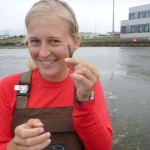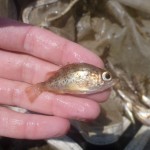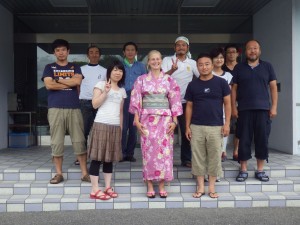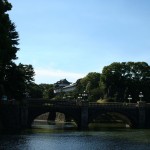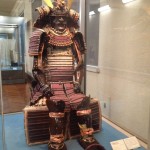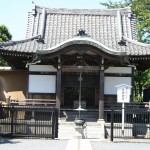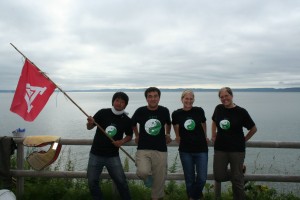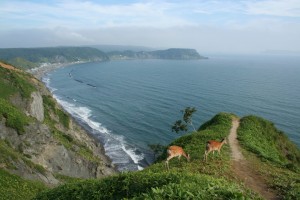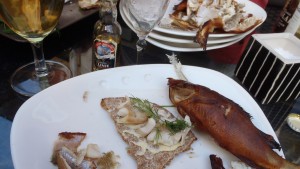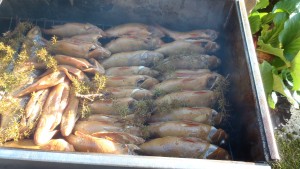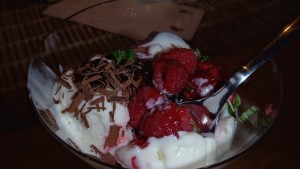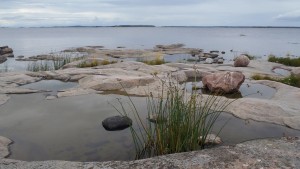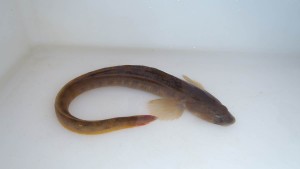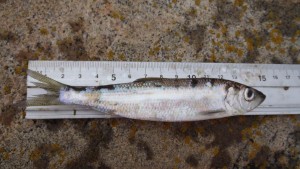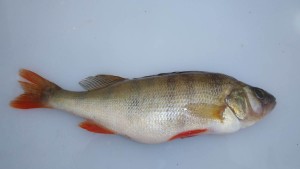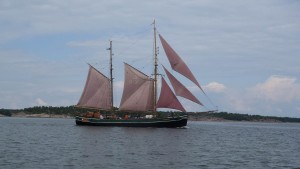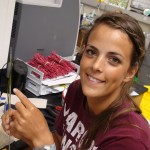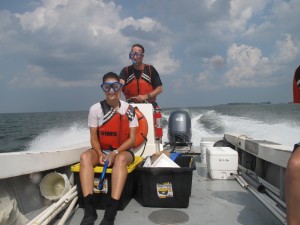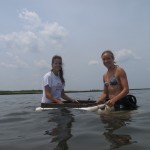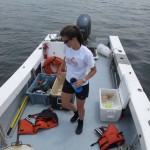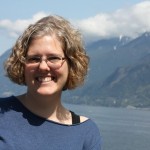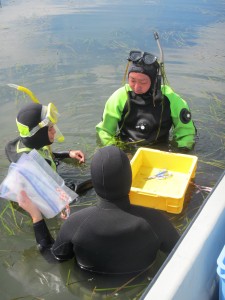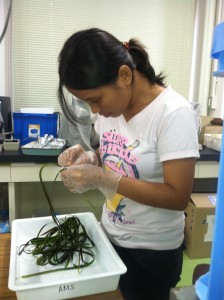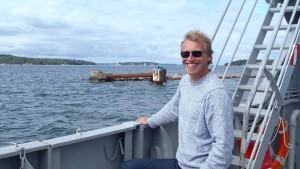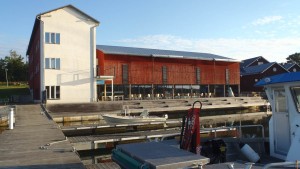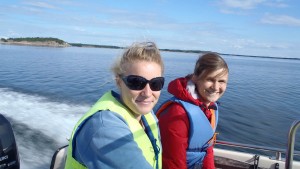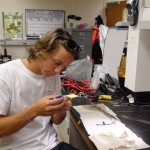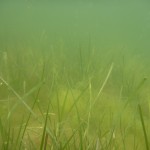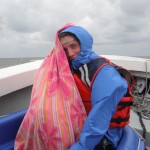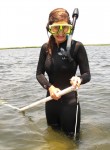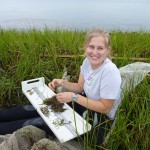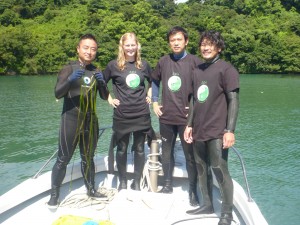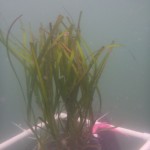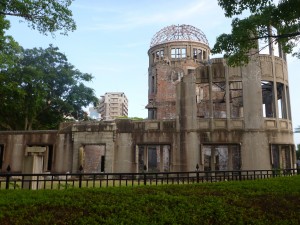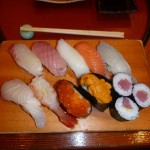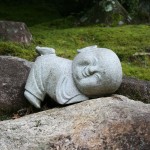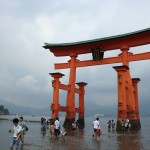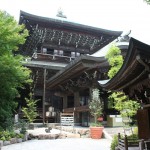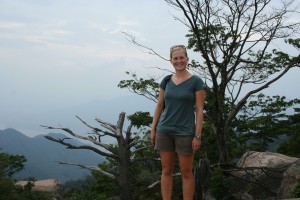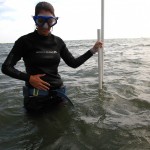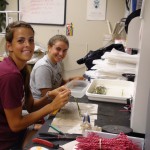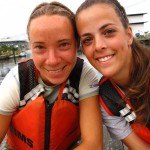Sayonara Hiroshima, Konnichiwa Akkeshi
by Rachel Gittman (ZEN graduate fellow)
After nearly a month in Hiroshima, it was almost time for me to make my way to Akkeshi to help Dr. Nakaoka and Nicole Kollars, the other ZEN graduate fellow in Japan, process samples post-breakdown of the ZEN main experiment. The experiment tests the interacting effects of mesograzers and nutrients on seagrass ecosystem function through the use of a grazer deterrent rather than traditional caging techniques. Before I left Hiroshima we had one more experiment to run testing the roles of predators in local eelgrass beds, and then I was off to Tokyo for a few days with Hori-san.
Conducting assays to test the strength of predation by small fishes and crustaceans on mesograzers at our field site was a fairly straightforward process, but was particularly challenging when the tide was up and the current strong. We experienced both of these conditions during our last predation assay. The water was too deep for setting up the assay by snorkel, so Hori-san and Hamaoka-san completed the assay with SCUBA. Shimbukoro-san and I used snorkels to set and collect minnow traps, which provide data on the abundance and composition of the ambient predator community. We caught several small fish in each of the minnow traps, primarily gobies and rockfish, but we decided to conduct additional fish sampling using a modified seine to get a better representation of the fish diversity at this site.
On my last day in Hiroshima, the lab surprised me with a Yukata, a summer time kimono and a farewell dinner. The next morning as Dr. Hori and I headed to the airport, I grappled with the realization that my time in Hiroshima was ending. This was not an experience I was likely to forget, but I knew that I would genuinely miss my new friends.
Finding my way in Tokyo
Before heading to Akkeshi to help Dr. Nakaoka with the ZEN experiment’s at the northern Japan site, I spent a few days in Tokyo. Tokyo is overwhelming to say the least; just stepping off the train into Tokyo Station makes you realize how large and bustling of a city it really is. You could spend an entire day just in the train station with all of the shops and restaurants, but fortunately I had time to make it out of the station and see two of the major tourist attractions in Tokyo: the Imperial Palace and Ueno Park.
Although you can only enter the palace two times of the year (new Year’s day and the Emperor’s birthday) without a scheduled tour, just seeing the outside of the palace was worth the walk in the hot August sun. Ueno Park is a large park in central Tokyo that includes numerous museums, temples, shrines, and a zoo. Although I didn’t have time to see it all, I enjoyed the exhibits in the Tokyo National Museum and visiting the shrines and temples throughout the park.
Akkeshi: a different climate
From Tokyo I headed north to the town of Akkeshi where I would spend the next week assisting with the ZEN research. Compared to the fast pace of Tokyo, Akkeshi is like a different world. Akkeshi is a small, quiet fishing town on the Pacific coast of Hokkaido, the northernmost island of Japan. The marine lab where the northern Japan ZEN team was based is located just outside of Akkeshi, within a National Park.

ZEN graduate student exchange fellows Nicole Kollars and Rachel Gittman marvel at how tall the eelgrass is in Japan
After a warm welcome from Dr. Nakaoka, his wife, the lab and a minor earthquake (although it didn’t feel so minor to me), I jumped into sample processing. The fieldwork for the main experiment (see Nicole’s blog) was complete, but we had a lot of samples to process in a very short time. Although I had processed samples for ZEN in North Carolina before, sample processing in Akkeshi was a little different. Simply put, everything is just bigger in Akkeshi. The seagrass is bigger, the grazers are bigger, and, naturally, the epiphytes are bigger. Filtering the epibionta scraped from the eelgrass shoots was a challenge because of the large scale of all of the organisms.
Fortunately, because of the dedication of the lab, we were able to complete sample processing in the week that I was there and I still had time to hike to the top of the cape above the lab with Nicole and witness to breathtaking sunsets. We also made sure to sample some of the delicious ice cream made fresh from a local dairy just outside of town.
Before I knew it, it was time to leave Akkeshi, but not before we spent our last night eating sushi and celebrating with the lab at a wonderful local restaurant. Although my trip was not quite over, this was my last day working with the ZEN team in northern Japan. I truly enjoyed the experience and learned a great deal from our Japanese collaborators. Hands-on experience conducting multiple field experiments in entirely different environments (North Carolina, Hiroshima, and Akkeshi) was eye-opening for me and gave me a new perspective on collaborative research. I have tremendous respect for the ZEN partners all over the world trying to make this project a success in their own unique environments.
I’ll end the blog here, but see my and Nicole’s final joint-blog for the highlights from our travels in the land of the rising sun.
Embracing local language, food and traditions in Finland
by Paul Richardson (VIMS technician)
Language and Culture
Before arriving, I didn’t realize that 75% of the people here speak Swedish and not Finnish. I’ve heard it can be a problem for kids who don’t learn Finnish when they go to find work in the city. One thing that is lucky for me is that most everyone speaks English. However, I usually have to warn people or they will assume that I speak Swedish. Apparently my Scandinavian heritage lets me blend in well here in Finland. Anyhow, I’m learning a few basic phrases and I even conducted an entire transaction at the grocery store the other day without speaking any English! Gå Svenska! (Go Swedish!)
A common language – food
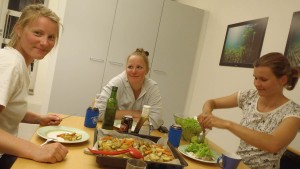
After a hard day of fieldwork, Paul relaxes by cooking a delicious meal with the graduate students working on the ZEN project in Finland
I’ve been able to practice my Swedish and Finnish both when visiting the home of the Boströms, my wonderful hosts here in Finland. Three times now the Boström’s have invited me to their lovely country home for some of the most amazing meals! The first one involved a “pastry” with chanterelles. I would equate it to a much enhanced quiche. It was amazing. I should also mention that they always also have an amazing assortment of cheeses, meats, olives and crackers as hour’s devours regardless of the main course. Talk about host hospitality!
Then the other night, in a pure Norwegian tradition, we smoked some perch and white fish in the most amazing way. Chris has a smoking box that he put aspen wood chips and sugar cubes into the bottom of. I brought some gutted and salted fishes that we put into the box on a grate over the wood chips. Then Chris put juniper sprigs on top. Then he put the smoking box onto a wood fire for about 40 minutes. The result was amazing. You then take a fish and break it in half, revealing the entire skeleton which is then easily removed. With it they served a crunchy brown bread that we put butter, the fish and then sprigs of dill onto. This was served with beer and Norwegian anise liquor that was simply to die for. I had visions of Vikings as these delicacies melted in my mouth on their lovely patio.
After every meal, the Boström’s always have some wonderful dessert. With the fish it was a humungous and delicious blueberry pie a la mode, and after the chanterelle pastry it was just the ice cream but it had Finnish chocolate shavings and they made on the spot a sweet sauce with fresh raspberries, blueberries, and (I never would have guessed it) basil! Oh my goodness! I never realized before coming to Finland what wonderful culinary treats I would be in for.
Embracing local traditions – the polar bear plunge

Paul’s face right after he came up from his first “polar bear” style plunge into the frigid Baltic Sea without a wetsuit!
One Saturday while on a nice bicycle that Minna and Christoffer’s friend loaned to me, I got a flat tire about 10 km from my home base at the lab in Korpoström. I walked back and so I was pretty tired and ready for a beverage when I quickly checked my email first. Out of the blue Christoffer had emailed me to tell me that my trip to Finland would not be complete without doing two things: first, jump into the Baltic (without a wetsuit) and next go sit in a sauna, with a few beverages in between. It was such a niec day I thought, what the heck! I did 4 cycles of this. I think they call it a polar bear plunge or something like that back home. Wow, 16oC water will really remind you that you’re alive! I won’t say it was nice, but it certainly was invigorating! Marie later told me that many of the locals do it in the dead of winter by cutting a hole in the ice. I think I might be a little too wimpy for that. But, give me a drysuit and some mesograzers to catch and I’m your man.
The Natural Beauty of the Archipelago Sea
by Paul Richardson (VIMS technician)
ZEN-like surroundings in the Archipelago Sea
The Archipelago Sea is like no other place that I’ve ever been. It’s completely different from the Spartina mud flats and warm eutrophic waters that I’m used to in Virginia. The glacier scoured bedrock islands go on forever. They are mostly granite with a variety of low vegetation and trees. The trees are usually small, some approaching bonsai status. I’ve seen fully mature miniature pine trees growing in a very limited amount of soil that collected between a few rocks. Also stunting them are the arctic winds and sea spray that blast them incessantly.
On the outer islands trees are absent altogether. But, these short sometimes bonsai trees and the lichen encrusted bedrocks remind me of what we have in the Appalachian Mountains but instead of being at 900 meters elevation, it’s all essentially at sea level. Unlike the small muddy islands of the coastal plain in the lower Chesapeake Bay, these rocky islands were created by glaciers and they’re are all rising due to the rebound of the land after the glaciers retreated. The average rebound is about 8mm per year! At this rate, sea level rise will not submerge these islands. In fact the curator of a local museum told me that he knows people who are frustrated with places where once viable waterways are now fields. We have the opposite problem in the Chesapeake region, where the islands are sinking and ultimately disappearing. The islands of the Baltic also hold many surprises in the form of Japanese ZEN water features. You can never create a more beautiful water feature than can nature.
More Baltic to Chesapeake Comparisons
To better visualize the extent of the Baltic I like to compare it to the estuary that I know so very well, The Chesapeake Bay. The Baltic is a much larger estuary. It is over 5 times as long at 1600 km whereas the Chesapeake is 300 km. The Baltic has an average depth of 55m whereas the Chesapeake has an average depth of 14m. The area of the Baltic, at 377000 km2 is over 30 times that of the area of the Chesapeake at 11601 km2. But most striking to me is the difference in the salinities between these two bodies of water. Having a relatively broad mouth and a shallow basin the Chesapeake has a much higher salinity of about 20 psu in the lower portions, whereas the Baltic with its narrow strait has a much lower salinity of 6 – 8 psu. However, in the deeper holes in the Baltic, there are super stratified salty “basins” that are anoxic and harbor huge sulfur communities.
So even though both systems have Zostera marina and the epifaunal grazers are similar, there are vast differences in much of the fauna between the two estuaries. The Chesapeake with its extreme temperature variation, wide open mouth, and saltier water has many more transient marine fishes that change with the seasons. The Baltic is more of a closed system with salmon, pikes, cyprinids, and perches (see the pictures to the left of some of the fish I caught at the ZEN site here in Finland). Similarly, however, in the eelgrass beds, both estuaries have gobies, pipe fish, sticklebacks and blennies.
Pack Ice
In contrast with the Chesapeake, here in the Baltic researchers have to contend with pack ice, which forms in November and lasts until early spring. Christoffer told me that every five or so years the ice freezes so thick that ice experts assess and plow it and make designated official roads to accommodate the transport of supplies such as building materials to islands in a way that is much more efficient than by boat (think Ice Truckers). I’ve seen ice on the Chesapeake, but it has never been thick enough to drive a truck on, much less walk on! Chris also said that if it’s calm and it doesn’t snow, then some of the most amazing ice skating conditions will occur. Too bad I head home before the cold weather sets in.
Traditional Wooden boats
During the summer time, however, boats are still the most common means of transport among the islands. I’ve noticed that in addition to the more commercial ferries, there are a lot of traditional wooden boats in the Archipelago Sea. It’s an art that has returned in recent years. Many people are restoring the old wooden boats, including Christoffer! He has several including a 7 meter Swedish racing boat that he restored and maintains. He purchased it when he was a graduate student so that he and his wife Minna (who’s also a research scientist) could get away when they had a break from their studies. Purchasing an island on a graduate student income was out of the question so they got this lovely wooden boat.
The Changing Baltic Sea
Temperatures are dropping, we’re having more storms, days are getting shorter, and fall is almost here. Summer, it seems, was over in a day. There will be more posts on the sporty conditions that we’re beginning to experience and will be experiencing more often with the changes in the seasons. To be continued as ZEN 2012 in Finland marches on!
Memorable moments in Virginia
by Katelyn Jenkins (College of William and Mary undergraduate student)
Many of the jobs I’ve tackled this summer have surprised me. I would not have guessed that I would become a PVC cutter, plaster block-maker, wire bender, mesh cutter, or sewer. However, I have learned that it takes a lot of skills, laughter, and water (often with a dash of Gatorade!) to prepare for such large-scale experiments in marine ecology. Through spending days of cutting many pieces of PVC and the messy job of making plaster blocks, I have enjoyed this job because of the new friends I have made in the MBL lab. From having numerous nicknames to help distinguish myself from the lab’s REU (also a Caitlin), to dancing on poles marking experimental cages in the field, this summer has been a great one to remember.
When I am not counting PVC or cutting wire, I have taken over the job of transferring seagrass samples from various ZEN partner sites to reinforced vials to grind down for nutrient (carbon and nitrogen) analysis. To do so, I have to go to William and Mary’s main campus to use a machine that will grind the samples (affectionately known as “Shakira” by its owner, Dr. Kerscher, who graciously allows us to use his lab space). The first few times I went to the main campus to grind the samples, the machine was placed in a lab. However, all of the large samples from partner sites makes for a very tired and warm ‘Shakira’. To resolve this, I planned to take breaks between sample grinding during my next visit. But, when I arrived on campus weeks later in almost 100° F weather in my shorts and t-shirt, I had no idea the machine was being moved to a cold room of 34° F! Though the initial “air conditioning” felt much needed, I quickly found myself freezing (literally) while trying to grind my samples. With multiple “defrost-Katelyn” steps inserted into the protocol (which involved running outside into the muggy Virginia heat until my fingers had thawed), I was able to successfully grind all of the samples. I can now say that I always come prepared with full gear to face the cold room. You can easily spot me walking across campus as I am the only one with a big jacket and pants in the middle of summer!
Aside from the strange climactic working conditions, I spend a lot of time in the field – one of my favorite parts! I have learned to master “Snorkeleese”, the language when talking with a snorkel in your mouth and your face down in the seagrass bed. “Ooo uoooo eeeddd elpppp?” translates easily to “Do you need help?” and “ablee eye eeese” almost always means “cable tie please”. All joking aside, most importantly I have had the chance to snorkel in the Goodwin Islands and see tons of marine life, all while learning the ins and outs of getting experiments set-up and broken-down in the field.
After taking a Marine Ecology course at William and Mary, it has been very exciting to see a lot of the things that I have read many papers on. For example, I read many papers on seagrass beds and algal blooms in the Bay and it is very interesting to see these different topics hands-on. One of the most interesting experiences I have had with marine life during the ZEN project was during the break down phase. While riding from our field site back to VIMS, about 15 dolphins began to swim around us as they searched for food. It was very exciting to see these animals so closely, especially because I have never seen so many in the York River before! Aside from this, I have had the opportunity to see tons of crabs, fish, and even sting rays!
Overall, this summer has been an incredible experience that has taught me many valuable skills. I can’t wait to see what lies ahead!
ZEN – a truly international effort
by Nicole Kollars (ZEN graduate research fellow)
“Many hands make light work.”
I like this quote from John Heywood. With the breakdown for the main ZEN experiment in Akkeshi quickly approaching, I became nervous that with only four pairs of field hands we would not be able to accomplish all of the necessary sampling in a timely manner. When I helped break down the ZEN site in North Carolina early this summer we had a small army of seven collecting field samples, removing the experimental materials, and processing the samples. And in North Carolina we were all native English speakers, which streamlined field communication. But, during my time working with the ZEN team in northern Japan I have been constantly reminded that even just a few well-coordinated hands can make a massive amount of work manageable. The breakdown was no exception.
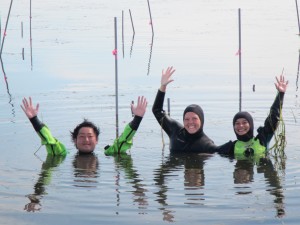
Kyosuke, Nicole, and Dr. Khwan Whankpetch during the breakdown of the ZEN experiment in Akkeshi, Japan
With 3 people in the water and 1 person on the boat handing out supplies and organizing the samples, we managed to break down the site in a smooth and efficient manner. Despite our relative lack of numbers, we managed to complete the experimental breakdown with its numerous sample collections in just two trips to the field site. I was amazed by this – not because we completed the work, but because we came to the field from four different countries. A Japanese (graduate student Kyosuke Momota), an American (me!), a Thai (visiting scientist. Dr. Khwan Whankpetch from Kasetsat University, Thailand) and a Filipino (visiting prospective student Venus Leopardas) all united together under the common mission of the Zostera Experimental Network – to produce great science.
The language barrier certainly posed a stumbling block in communicating with one another. This was especially challenging when difficulties arose and we had to work together to come up with a solution or when we were trying to find the best way to divide the work. It is a humbling experience for me because even though I am the foreigner to this country, communication is catered to my native tongue and we speak to each other in English. I wish I could say that I have learned more Japanese during my time here. I’ve mastered niceties such as “good morning” (ohayou gozaimasu) and “thank you” (arigato gozaimasu), but a full conversation is not possible – yet.
I continue to be astonished by how many languages the people I have met here not only understand but speak and read. For example, not only does Khwan speak Thai but she is also fluent in Japanese and English. Then there is the matter of the Japanese characters. In addition to learning the English alphabet, Japanese children learn three different sets of characters: hiragana, katakana, and kanji – there are over ONE THOUSAND characters in total! I have only mastered one – the “on” button for the washing machine.
Communicating in the field
Despite the language difficulties, we have learned to anticipate what one another needs and to find creative ways to express ourselves. By choosing our words carefully and speaking clearly we can usually get our point across. However, it is not to be underestimated how much you can say without saying anything at all. Through my experiences here in northern Japan I have come to realize how important thoughtful gestures and facial expressions are in average day to day communication. A smile definitely goes a long way! I have also found the ZEN experimental manual composed by Drs. Reynolds and Duffy to be invaluable. We use it both as a reference for the experimental procedures and as a tool for pointing out questions and providing answers. The methods videos accompanying the manual are also great as they show techniques that can be hard to explain even when everyone speaks the same language.
With all of the samples collected from the field, our attention turns back to the lab where the sample processing has begun. Kyosuke and I have been grateful for the help of Khwan and visiting researcher Ms. Venus Leopardas (Mindango State University at Naawan in the Phillipines). We are sad to see them leave as they return to their home countries, but we are happy to welcome ZEN student exchange fellow Rachel Gittman and undergraduate intern Ms. Minako Ito (Hokkaido University) to the Northern Japan team as we finish processing this week. It is great to be reunited with Rachel after working with her at the ZEN site in North Carolina. Stay turned for our upcoming co-authored blog entry “North and South unite!” There we will highlight our last week here in Akkeshi and our experiences as we travel across Japan before returning home. It’s incredible to think that our 6-week adventure is almost at an end!
Dispatches from Finland: Arrival
by Paul Richardson (VIMS Marine Biodiversity Lab technician)
The Long Journey from Virginia to Turku and then Korpoström
At over 6500km, traveling to Finland was the longest journey I’ve ever made. At 42 years of age I’ve never been out of North America, and traveled only once outside of the United States (a brief ski trip to Canada a few years back). With all of the ZEN research going on at VIMS right up until my departure, I had little time to be nervous for my first true international travel experience. My United flight on a spanking new 757 provided surprisingly good food, and there was a selection of movies. One thing, however, that I really appreciated was the flight monitor where I could see the plane’s progress, its speed, the arrival time (which was always further away than I wanted!), the temperature outside of the plane, etc. Being the irrationally nervous flyer that I am, it was somewhat comforting to know that the altitude was 36000 feet, speed was 580mph, and the temperature outside was -60oF. Sitting upright and cramped, combined with my excitement for the trip, I couldn’t sleep a wink all night.
In Copenhagen I was thrilled to get my first passport stamp. Then I boarded a bus to go across the tarmac to a Scandinavian Airlines flight to Turku, Finland! The plane was pretty empty – the benefit of flying into Turku at the end of the tourist season. Every other seat was vacant, which would have been nice for the trans-Atlantic flight.
During our approach, we flew right over the Archipelago Sea where we are conducting the ZEN experiments in Finland. I snapped a few pictures of some of the estimated 30,000 islands. Despite the cloud cover obscuring some of the smaller islands, it was comforting that the view looked like a more vibrant version of the Google Earth images that I viewed a few days prior.
Stocking Up with Provisions!
Once on the ground in Turku, I was thrilled to find that all of my bags made it through four connections and two airlines half way across the world. I was even more thrilled to find that ZEN collaborator, Dr. Christoffer Boström, was waiting for me just outside the gate. First we went to the City Market in Turku to stock up on food and other supplies before traveling to the marine station on the island of Korpoström . The City Market is amazing. It’s the size of a Super Wal-Mart back home, with a department store and a grocery store, but most of the food and produce is local and luomu (organic). I had no idea what any of the labels said, but Christoffer, a self-proclaimed food nerd, gave me the tour. When he said something was good, more often than not, it went into my cart.
With my blond hair and standing 6 feet tall, I didn’t feel terribly like I stuck out as a tourist until I asked for a grocery bag. Most of the stores in Finland (and I’m told Europe in general) do not give out grocery bags. If you don’t bring one, you have to buy one. City Market generously gave me one – my first welcome to Finland present! The bags are big so I managed to get all of my 100+ Euros worth of food into it. I got many delicious meats, breads, herrings (I love pickled herrings!) and luomu produce – tasty, but food here is not cheap! Cans and bottles have 15 cents tacked onto the price of each so that you can bring them back for 15 cent refunds each. Didn’t we used to do that back in the States?
A Little More on the Subject of Food
The summer in Finland is an amazing time to visit if you’re a food nerd (or foodie, as we say). Because the sun shines for so long during the day, and at a low angle, the produce is extremely flavorful. Carrots and potatoes and other veggies are about half the size of what I’m used to in the U.S., but they are twice as flavorful. You can also go into the woods and pick berries. You’re even allowed to go onto private property as long as you stay at least 300 meters from any dwelling. With long days of fieldwork and lab processing I haven’t exactly had time to go berry picking in the woods, but I have picked a few on the side of the road and I’ve bought more than a few. If you do plan to go berry picking in Finland though, you need to beware of ticks and getting lost. Apparently, more than one berry picker has fallen victim to ticks and their associated diseases or wandered away and never made it home. The good thing about being on a small island like Korpoström where the marine station is located, is that if you do get lost you can always walk until you find the coast and then follow it home.
My New Digs
After the trip to the market, Christoffer and I took a two hour scenic drive and two ferry rides to my new home for the rest of the summer in Korpoström.
Åbo Akademi University’s field station is in Korpoström which is an island in the Archipelago Sea. This facility is a unique melding of modern art, science, and recreation. On one side you have the Strandboden (beach hut) that is basically a hotel with a marina. Then on this side there are the Åbo Akademi labs, offices and my quarters (a modified office). The park service also has some space and there’s a restaurant and a museum. All of this is situated conveniently on the water where our research vessels are located. I’ve been to the restaurant three times and it is delicious, but mostly I cook my own food purchased from the market trip in the little kitchen upstairs. Listening to all the numerous non-English conversations going on at the Strandboden and the restaurant, I still feel like a tourist, very far from home. But, I am slowly becoming accustomed to my new surroundings, and I can definitely spot the tourists. They speak English.
The Finland 2012 Crew
In addition to Christoffer and myself, there are three very skilled graduate students helping out with the ZEN work: Marie Järnström, Camilla Gustafsson, and Anna Törnroos. Anna was here for one week for the set up and to be Camilla’s dive buddy. Camilla is a PhD candidate at Åbo Akademi University who will be defending soon. Marie is Christoffer’s intern and a master’s student of Åbo Akademi; she will leave to continue her studies at the end of August. These gals are all pretty much locals. Among other languages, they all speak Swedish and, luckily for me, they all speak English very fluently. I’m not sure exactly where Cami and Anna are from, but Marie is from the island of Mossaia, which is three ferries to the North West.
That’s it for now – I’ll save descriptions of the field site and the natural history of the Archipelago for my next dispatch.
The business of science
by John Schengber (VIMS undergraduate student summer intern)
I am an undergraduate at James Madison University and have been working this summer with the ZEN team at the Virginia Institute of Marine Science in Gloucester, Virginia. I have lived right across the river in neighboring Yorktown for most of my life. Surrounded by nature and adventure, I have become an outdoor kind of guy with an intense curiosity and respect for nature. I still have not decided the exact career path I want to take, so this summer was an excellent opportunity to explore research and marine biology.
I think most people in the lab were surprised when I revealed that I am in fact a business major. Everyone else around here studies (go figure) science. In the fall, I will be returning for my sophomore year at James Madison University, where I am pursuing a major in International Business coupled with a double minor in Spanish and Environmental Science. Now, why in the world would a business major be working in a science lab? First, let me emphasize that this career direction is not entirely definitive for me. I am fascinated by a myriad of fields of study. In business, I am drawn to the ideas of entrepreneurship and creativity, but not so much to the possibility of cubicle entrapment. I dream of running my own company, but am conflicted as business/industry can often be a driving force in the destruction of our natural world.
My love for science stems from my love for nature and the questions it begs us to answer. I am in constant awe of its wonder, and my life would be at loss if my studies lacked a good dosage of the biological sciences. Yet I love to interact with people (especially in Spanish), to solve problems, and to try new ideas in the business sector. So, I have come to a crucial intersection of interests. Business seems to be the last thing to enter if one is focused on saving the world from its own ruin. But I wonder if it can be done differently? Can we make a business that is not just sustainable but truly symbiotic with our environment? Most importantly, can this venture be profitable in a cut-throat capitalist economy? Lastly, can I be the person to do this? I have no idea. But I’d say it’s worth a shot.
So here I am at the Virginia Institute of Marine Science taking that first step. I came into this position with a few hopes and expectations. I wanted to check out the work of a marine biologist, which is my greatest love in science and the field that I would most likely enter if I decided to pursue a research career. I hoped that I would meet some incredible people with inspiring intelligence and personalities to match. I wanted to view the process of scientific investigation from beyond classroom instruction or media coverage. I wanted to learn a lot and experience even more. But really I just wanted to hang out with some amphipods.
All of my hopes and expectations have been fulfilled, and I have loved every minute of it. I have made new friends and linked up with old ones (see Nicole Rento’s post, fellow lab member this summer and best friend since, well, forever). I have learned more than I could have ever imagined. I have spent some quality time with lots and lots of amphipods. And I’ve learned that running a lab really isn’t too much different than running a business. There are budgets, deadlines, management, and lots and lots of ingenuity. Maybe there’s hope for me yet.
Calling all undergrads – get your hands on some science!
by Pamela Reynolds (ZEN Coordinator)
Calling all undergraduate students at the College of William and Mary, and surrounding colleges!
The Marine Biodiversity Lab at VIMS has several open positions this fall for research internships in marine ecology, evolution and biodiversity research. Students will receive hands-on research experience involving instruction in both laboratory and field techniques, as well as exposure to cutting-edge research being conducted in the Marine Biodiversity Lab at VIMS.
Research opportunities are in two areas: (1) Ecology of seagrass food webs, as part of the Zostera Experimental Network (ZEN, www.zenscience.org), and (2) Comparative ecology, evolution, and behavior of social shrimps from Caribbean coral reefs.
No experience is necessary, although we encourage applications from detail-oriented students with strong work ethic and communication skills.
Students will be instructed in the use of dissecting microscopes and other tools to identify and quantify local marine flora and fauna of the Chesapeake Bay and other estuaries (ZEN), or of Caribbean invertebrates. Students can expect to gain a strong working knowledge of the scientific process, basic taxonomy and ecological roles of marine organisms, and a greater understanding of fundamental ecological and evolutionary principles. Students will work closely with graduate students, postdoctoral researcher and staff scientists in the Marine Biodiversity Lab (http://www.vims.edu/research/units/labgroups/marine_biodiversity/index.php).
We are recruiting up to 5 students for these volunteer internship positions. Students may earn up to three course credits of MSCI 490 Research in Marine Science.
Students interested in working in this dynamic research environment should e-mail a copy of their resume and unofficial college transcript, with contact information for one WM faculty member who knows you, to both Drs. Pamela Reynolds (reynolds@vims.edu) and Emmett Duffy (jeduffy@vims.edu) to learn more about the position(s). If interested in course credit, contact us ASAP as the add deadline is fast approaching (Sept. 7th!).
Science and Site Seeing in Hiroshima
by Rachel Gittman (ZEN graduate student fellow)
Even though I have only been in Japan for three weeks, I am really beginning to feel a sense of home here. I have experienced so much since my last blog, but the most rewarding experience has been becoming part of the marine lab here in Hiroshima. Hori-san, Hamaoka-san, and Shimabukuro-san as well as the other members of the lab have made me feel both welcome and comfortable. We have lunch and afternoon tea together each day and although I am still struggling to communicate at times (I wish I could say my Japanese is improving, but I haven’t really gotten past basic greetings and responses), I am learning so much.
We have been very busy over the last few weeks with two ZEN experiments – a short term assay to examine the intensity of predation on mesograzers and a longer experiment to examine predator effects on the seagrass community. Thanks to the hard work and dedication of the lab, all of the experiments have been running smoothly thus far. After a week of cage building, we were ready to set up the longer predator exclusion experiment. Setting up the experiment here is a little different than setting it up in Virginia or North Carolina because our site is entirely subtidal and it gets pretty deep when the tide rises.
Hori-san and Shimbukoro-san used SCUBA to set the cages, while Hamaoka-san and I snorkeled above them, holding our cages on a long rope leash. The entire set-up took about six hours and I was able to capture about half of the set-up in a timelapse from shore.
Although we have been busy with our field experiments, the lab was kind enough to take me out for my birthday and gave me a great birthday present: cake and my own house shoes (very important to have in Japan). It was a wonderful birthday surprise and I am glad I was able to spend my birthday in Japan.
I share my birthday (August 6th) with the anniversary of the a very tragic day in history, the detonation of Little Boy, the first atomic bomb used in World War II. I was able to visit the Atomic Bomb dome, the remnants of the government building that was almost directly below where the detonation occurred, and the Peace Memorial Park. Visiting those sites was a humbling but positive experience because of ongoing efforts by the Japanese people to encourage world peace.
Beyond just seeing the sites, visiting Japan has also been about the experiences and more importantly the food! After much anticipation on my part as an avid sushi-lover, my hosts took me to a Japanese sushi restaurant in Hiroshima City. I could hardly contain my excitement as we sat down to order at the sushi counter. We had a perfect view of the chefs preparing the sushi and I was determined to try everything. Needless to say, I was not disappointed. The sushi was amazing and included some items that were new to me, such as squid, octopus, and urchin. The atmosphere, food, and my new friends made the night one that I am not likely to forget.
I can’t end the blog without sharing a few more of my site seeing adventures.
Over the weekend and this past week, I had the opportunity to visit some of most beautiful and historic places in this part of Japan: Miyajima and the Iwakuni Kintai bridge, in addition to the peace and atomic bomb memorials in Hiroshima City. Miyajima is a World Heritage Site just a few kilometers and a short train and ferry ride from the FRA Institute. The island contains many historic sites, including the Otorii Gate, Itsukushima Shrine, and Daishoin Temple, as well as nature trails that lead to the top of Mt. Misen.
After exploring the temples, shrines, and the public aquarium I decided to hike to the top of Mt. Misen to get a good view of the area. Along the way, I happened to meet a fellow North Carolinian, and we decided to hike up together. It was a good choice, because the 3km hike was very steep and the humidity and heat made reaching the top quite an accomplishment. The view was worth it though and the descent was much more pleasant.
I want to save some of my site seeing for another blog post, but I will briefly mention the Iwakuni Kintai bridge. Built in the early 1600s, it was deemed “indestructible” because of the superior engineering design and construction, well ahead of its time. The bridge is not only impressive from an engineering perspective, it is also incredibly beautiful. Although the bridge was partially destroyed in the early 20th century, it was restored to its original glory a few decades later and it still maintained in its original design and structure. Seeing the bridge just as the sun set was worth the wait. Having to wait for it to get dark also meant I could get more ice cream – this time I went for mango. I am pretty sure I have eaten more ice cream here in the past three weeks than I have for all of last year. What can I say except that it is just delicious!
The start of something new
by Katelyn Jenkins (College of William and Mary undergraduate)
My name is Katelyn Jenkins and I am a lab technician here at the Marine Biodiversity Lab at the Virginia Institute of Marine Science in Gloucester Point, Virginia. This year I will be a junior at the College of William and Mary where I am majoring in biology and minoring in marine science. As a local from Yorktown, Virginia, I have become fascinated with the environmental and economic importance of the world’s largest estuary just down the street – the Chesapeake Bay.
I became involved in research at VIMS during high school in 2008 where I worked in a Marine Conservation and Biology lab. Immediately immersed into field and laboratory work, I knew right away that marine science was a field I wanted to pursue. During 2009-2011 I began working on a research project at William and Mary that aimed to identify and characterize a harmful bacterium recently identified in striped bass in the Chesapeake Bay. Although the topic excited me, it wasn’t until I spent 2 years indoors running multiple PCR’s day after day in the lab that I knew I needed to get back into VIMS where I could study marine science on a much larger scale. In 2011, I began volunteering for Dr. Emmett Duffy in his Marine Biodiversity Lab where I learned to identify various types of seagrass, algae, and LOTS of what we affectionately call ‘bugs’ (small marine invertebrate grazers). Recently I put these new skills to the test when I returned to the lab to work as a technician for the summer.
This summer began on a busy note. I arrived at VIMS the day after I returned from a field course on the Eastern Shore. I had just enough time to unpack before I needed to repack my bags to head to Beaufort, North Carolina with our lab manager Paul Richardson to break down an experiment with the ZEN team at the University of North Carolina’s Institute of Marine Sciences (IMS). It was an exciting trip where I had the chance to meet and work with Erik Sotka and his lab group from the College of Charleston in South Carolina in addition to local NC graduate and undergraduate students. My first field experience with this lab group was an exciting one – there is a broad diversity of research projects and techniques employed in the ZEN. One of my favorite parts of the trip was having the chance to stay and work at IMS as well as learn about the ongoing research at this facility, as I have been thinking about potential graduate schools and programs to pursue after graduating from William and Mary.
After returning to VIMS, I have been involved in helping with many projects and picked up new skills: plumbing, sewing, processing chlorophyll samples, taking and sorting biomass cores, and preparing leaf tissue samples for CHN analysis. Although it may seem busy, it has forced me to become mentally organized with all of the different things going on in the lab – something that I think is a very important ‘life skill.’ I have also found that I have gained a lot of confidence in my abilities to recognize what needs to be done, when it needs to be completed by, and what needs to be done to have it completed. There’s a lot more to science than just doing research. I’ve learned that the planning, management and constant juggling of tasks is just as important as actually processing samples.

